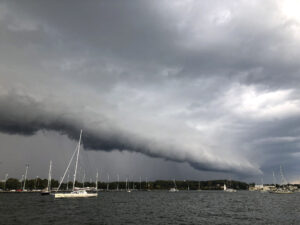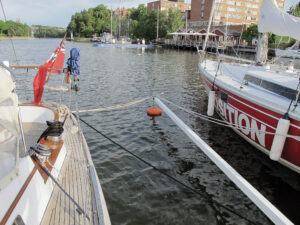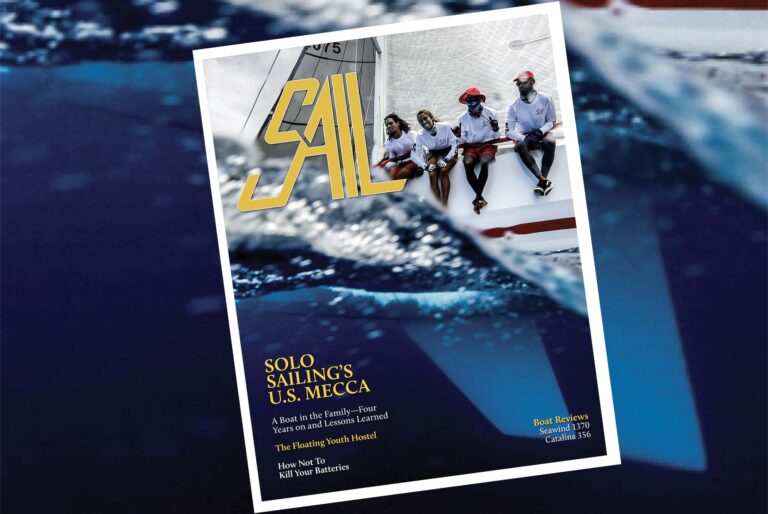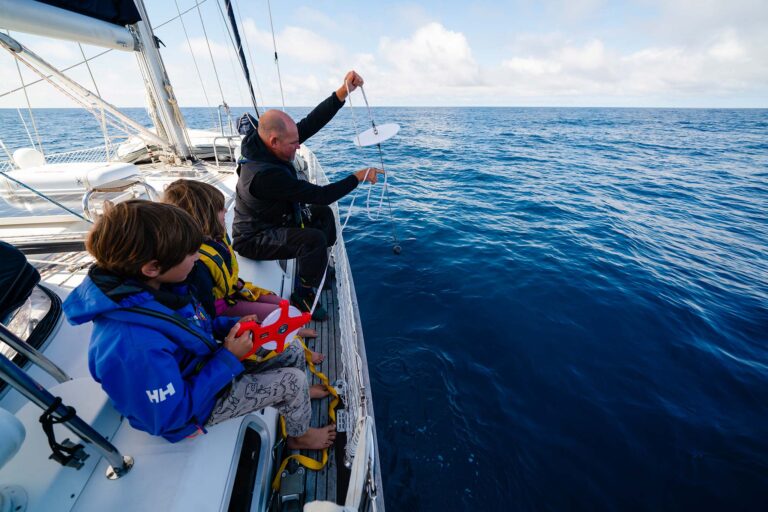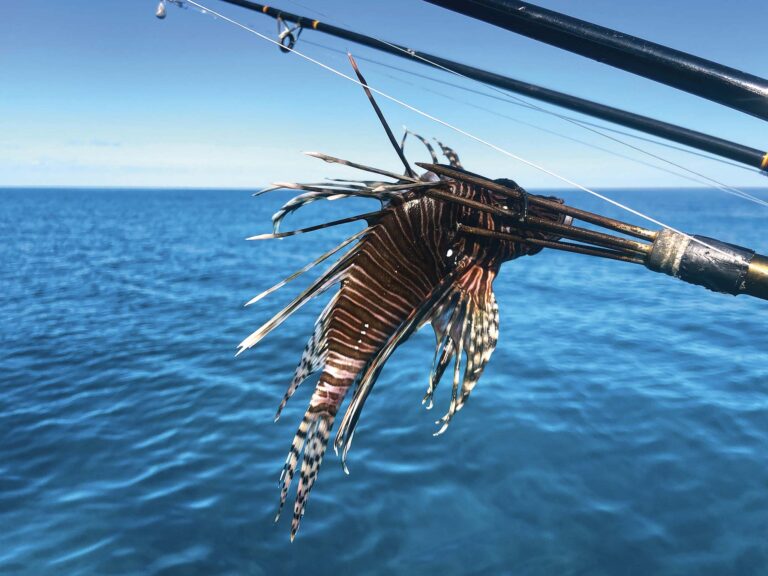
Our first encounter with a big squall was sailing from San Diego to Ensenada, Mexico. We left at 0200 to ensure we’d get into Ensenada before our 1300 haulout time. The National Weather Service had forecast consistent 15-20 knot winds from the northwest, which was perfect for the 60-mile run down the coast. We hoisted sails as soon as we were out of the San Diego Harbor channel, keeping a reef in the mainsail as is our policy for night sailing. The wind was exactly as predicted, and we cruised across the border under a moonless sky.
A short while later, as we were admiring the lights of Tijuana, we noticed the wind lessening, then backing to the west. “That’s weird,” I thought as I moved to trim the sails. Instantaneously, we were laid down by a 35-knot blast out of the southwest, the sails flogging wildly as the boat rounded up. Shocked we sought to get the boat under control. With our full genoa out and only one reef in the main, we were grossly over-canvassed.
After letting out the mainsheet I set about reefing the headsail as white spray flew over the bow. Once the headsail was furled to the second reef point and with the main traveller to leeward, the boat stopped wanting to round up, and the motion became more comfortable. The rain then arrived, and the wind dropped to an even 30 knots. As we scorched along at 7.5 knots, my wife, Fiona, and I both looked at each other and said simultaneously, “Squall!”

What is a squall?
The official definition for a squall, according to the National Oceanic and Atmospheric Administration (NOAA) is a “strong wind characterized by a sudden onset in which the wind speed increases at least 16 knots and is sustained at 22 knots or more for at least one minute.” A squall can also be defined as an area of strong, localized convection in which windspeed increases substantially for a duration lasting anywhere from a few minutes to a few hours.
In our experience in the Pacific Ocean, squalls usually blow in the 20 to 30-plus knot range and last an average of 20-40 minutes. Based on data gathered from Latitude 38’s Pacific Puddle Jump over the last five years (2012-2017), the average highest windspeed encountered on the crossing is a little over 32 knots and is almost always experienced in squalls. There have been reports of squalls in the 50-knot range, but this is rare, with 82 percent of boats reporting maximum encountered windspeeds of 40 knots or less.
Ten thousand miles later and after avoiding and experiencing countless squalls, Fiona and I have become much more adept at recognizing and responding to this interesting weather phenomenon. Squalls, almost by definition, are too small and localized to be forecast precisely. However, areas of the kind of increased activity that can form a squall line can be seen on weather radar and will be included in a local area forecast.
Visual characteristics
There are a few key indicators to look for when trying to identify a squall: namely clouds, rain and waves.
Cumulonimbus clouds: The first sign of a squall is typically a large cumulonimbus cloud built up with a dark, flat bottom. However, not every cumulonimbus cloud will have a squall under it, which is why it’s important to look for other indicators as well.
Virga: The second indicator of a squall is gray streaks underneath said cloud. These streaks are called virga and are the result of rain evaporating before it hits the ground. As the rain evaporates it also steals heat from the surrounding air creating pockets of cold air that can descend rapidly, causing strong gusts at sea level.
Rain: A dark slab of rain under a cloud is usually a good indicator that strong wind will be present, especially in the tropics and sub-tropics. The rain is often at a slant, as a result of the wind within the squall complex. Squalls, however, often move sideways to this slant, so don’t assume the cloud is dragging the rain behind it.
Waves: Another good indicator to look for are white caps on the surface of the water near large clouds—a sure sign that strong localized winds stirring things up.
Radar: Of course, these features are impossible to see at night, which is why we often use radar to identify squalls after dark. This tactic works because radar reflects off condensed water (rain), either in the cloud or at sea level. Either way, where there is rain, there is likely to be strong winds. A squall will appear as a hairy blob on the radar screen.

How to avoid squalls
Avoiding squalls follows naturally from being able to recognize them. However, just because you know what a squall looks like, that doesn’t mean you will automatically know where it is going. In fact, squalls often do not follow the prevailing winds, but rather move at an angle to them. In addition, large gusts can occur as far as two miles away from the squall’s cumulonimbus cloud, so be sure you don’t wait for it to get too close, or you may find yourself caught unprepared.
If it is light out, we usually start by taking a bearing on the squall. We might use a compass, but mostly we just line it up with a stanchion or through a dodger window. If we hold the same heading and the angle on the squall doesn’t change, then we know we are on a collision course: it’s the same principle at work as when avoiding other ships.
A few times we’ve tried racing ahead of a squall even though we knew it would be cutting things close. We’ve had mixed success with this strategy, having been caught as often as we’ve escaped, and we now prefer to let a squall roll by while we slow the boat or alter course to avoid it.
If we are sailing at night in a squally area, we generally run a radar sweep every 20 minutes, making sure the “rain scatter” mode is turned off or at minimum. Radar can be especially good at tracking a squall’s movement. It’s also good at providing an early warning that one is in the area. We sweep at a range of 12 and 24 nautical miles, although due to the curvature of the Earth, it is difficult to identify rain at sea level beyond 15 nautical miles. If a squall can be identified at, say, 9 miles away, then slowing the boat down just half a knot can mean the difference between getting drenched and staying dry.
Another strategy we’ve found useful when open-water sailing is relying on a self-steering windvane to keep the boat at a constant angle to the wind, so that as the wind shifts with the squall the boat shifts with it. This has meant sometimes sailing at right angles or worse to our original course as we skirt the periphery of a squall waiting for it to blow itself out. However, if you’ve got a way distance to go, a five-mile detour is no big deal. This approach also requires very little effort on our part, making it perfect for singlehanding at night.
The same effect can be achieved with an autopilot that is set to wind angle as opposed to course heading. However, don’t get complacent. Squalls are notorious for sudden windshifts, which can result in an accidental gybe and cause significant damage.
Sailing in a squall
No matter how hard you try to avoid squalls, eventually you will have to sail through one. Sailing in a squall doesn’t have to be an especially intimidating experience. In fact, it can often be quite refreshing as it helps spirit you on your way. At the same time, though, taking some precautions early on and knowing what to expect will pay dividends in terms of keeping both your boat and your crew safe.
If a squall is approaching, the first step is to reef sails. Expect increased windspeeds at least 50 percent higher than the prevailing conditions and reduce canvas accordingly. The adage “reef early and reef often” is a good one to follow. Being caught over-canvassed is a challenging and unenjoyable experience, to say the least, not to mention potentially dangerous for the boat and rig.
That done, make sure everything on deck and in the cockpit is well secured. It is also a good policy to put on foulweather gear or at least have it close by, as the cool rain can cause a chill, even in the tropics. The first strong gusts of wind associated with a squall are almost always the strongest. You’ll typically feel this wind before you feel the spattering of rain.
Once the rain hits, the wind usually lessens somewhat, but can still be gusty. Depending on where you are, how high and large the cloud is and the initial prevailing conditions, the wind will typically be anywhere from 25-40 knots. Often before and after a squall the wind will be very light, prompting us to turn on the engine to make headway after the squall has passed.
Many sailors recommend that you sail with the squall, or “go with the blow.” As is the case with the windvane strategy, this will almost assuredly take you off course. But staying on the periphery is usually preferable to sailing through the heart of a large squall, in particular. The reason for this is that the wind shifts in a squall can often be unpredictable, forcing you to have to trim sails, or even tack or gybe multiple times: a tremendous amount of effort that is hardly worth it given the squall will likely blow itself out within 20 minutes to an hour anyway.
Something to watch out for on those occasions when you do find yourself caught up in a squall is rounding up and out of control. For example, your sailplan may be working just fine on a run in 30 knots. But then a wave slews round your stern, or a gust hits, and the next thing you know the boat is turning up into the wind, completely out of control.
In fact, we’ve experienced a number of squalls in which the wind and waves overpowered the rudder in as little as 35 knots of wind. The problem was the mainsail was overpowering both the rudder and the headsail. Therefore, when running in front of a large squall, a triple reefed main and reefed headsail may be the best sailplan. You might even want to try sailing under staysail or reefed headsail alone, since keeping the nose of the boat downwind will make the trip both more comfortable and a good deal safer.
Many cruisers recommend that the best thing to do is simply motor through a squall with a triple-reefed mainsail or a reefed roller-furling staysail up for stability. Something to remember, though, is that with this kind of an unbalanced sailplan the rudder can still have problems keeping a good grip. That said, if you don’t mind burning diesel, this method will generally keep you on a more-or-less constant heading and also keep you moving in the lighter airs after the squall has passed.
Of course, the most conservative approach is to drop all sails and motor through the squall zone. However, while this technique can be a good one with a smaller sea state, when the waves get up to 10ft or more, motoring into or even across them becomes a daunting and not very comfortable prospect. At this point, it is better to get some sail up.
Ultimately, there are many factors at play in squall sailing, including sea state, windspeed, boat balance, the number of crew, the air and water temperature, and rig. The exact solution will, therefore, be different for every boat and a matter of playing around with what works best for you and your crew. A conservative approach is a good place to start. After a few squalls, it will quickly become clear what works best and what doesn’t.
Whatever you do, there’s no reason to be afraid aboard a well-found boat. While it’s good to approach a squall with respect, there is no reason to fear it. With good avoidance techniques, boat and crew preparation, and the right sails, every squall can be managed. Consider it a little burst of excitement on an otherwise placid day.
September 2018

